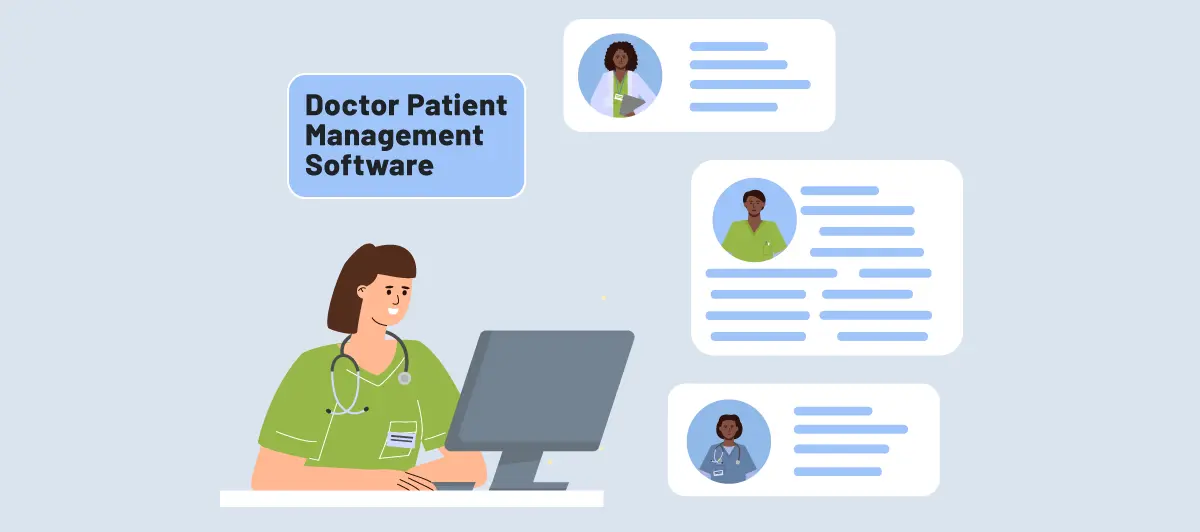What is Doctor Patient Management Software
Quick Summary: A tool that simplifies the hospital administrative tasks is the Doctor Patient Management Software system. It helps healthcare professionals to deliver better care and streamline their practices. Such high-tech clinical practice management software makes appointments easier, orders medical records in one place, and automates administrative tasks, which pulls doctors to their primary concern – patients. All the details about this software are going to be explained here.
Introduction
Earlier, when there were no technologies and tools to help manage hospital tasks, everything was just so tough to handle. However, time has now passed, and technology has advanced. Thus, there are many software and tools that are emerging and simplifying hospital tasks. One of those is Doctor Patient Management Software.
With this software healthcare providers can efficiently handle appointments, patient records, billing, patient portals, and administrative tasks in one unified system. It is fundamental to the day-to-day activities of the hospital. Medical practices and clinics are organized.
The software at the heart of this collaboration helps clinicians and the health care teams to facilitate patient satisfaction and care. It offers easy scheduling and monitoring of appointment reminders functioning as the no-shows prevention and facilitating timely treatment. Patient records, like medical history alongside laboratory reports or scanning results, are stored securely for later use, granting opportunities for accurate diagnoses and personalized treatments. Additionally, billing puts efficiency in processing of insurance claims with attention to details by making the financial aspect of healthcare easy.
Hence, let’s find out what a Doctor Patient Management Software is exactly and not.
Overview To Doctor Patient Management Software
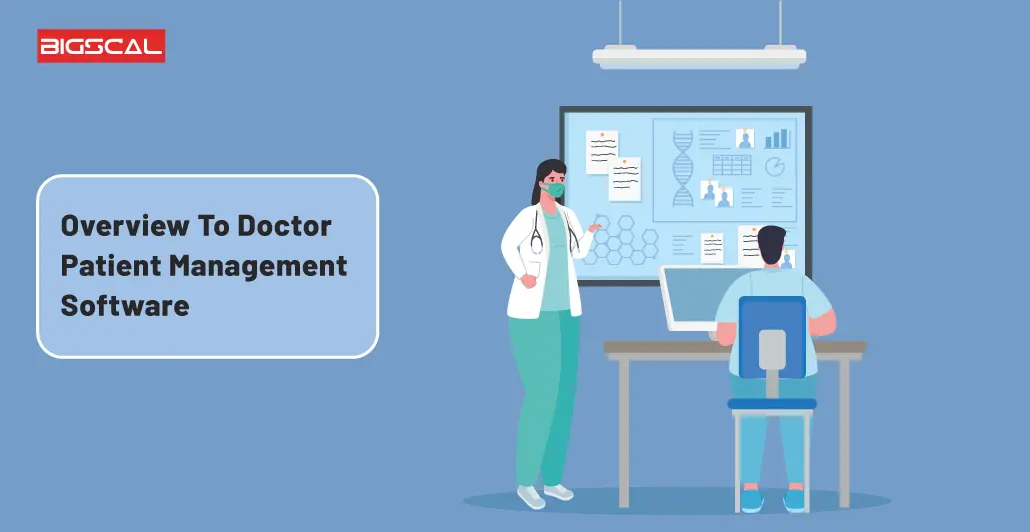
Doctor-patient management systems or software is one such tool that can facilitate the management of these services. It makes the overall process of health care easier since doctors and other medical staff can also organize the data regarding patients easily. Some of the functions of this software encompass appointment calendars, records, billing, and communication.
The file-sharing process between doctors can lead to even quicker access to patient records, medical history, and treatment plans, making the decisions more informed and thus increasing patient satisfaction and engagement. Along with providers, patients also gain ever-evolving opportunities. They can reserve time online and set reminders for appointments and prospects regarding their health data from PCs without a problem.
The software better medical care by eliminating bureaucracy, handling working tasks, increasing people communication, and meeting more needs, among others. It promotes grain engagement from patients and fosters interprofessional communication, thus, this mechanism results in more accurate diagnosis and treatment.
Since it provides a trackable document, it facilitates the claims and billing processes. Generally, the doctor-patient practice management system and software supplies superfluous functionality for the healthcare sector that not only upgrades care efficiency but also helps to gain more patient loyalty and satisfaction as it provides more smoother, safer, and organized healthcare environment.
Types Of Doctor-Patient Management Software
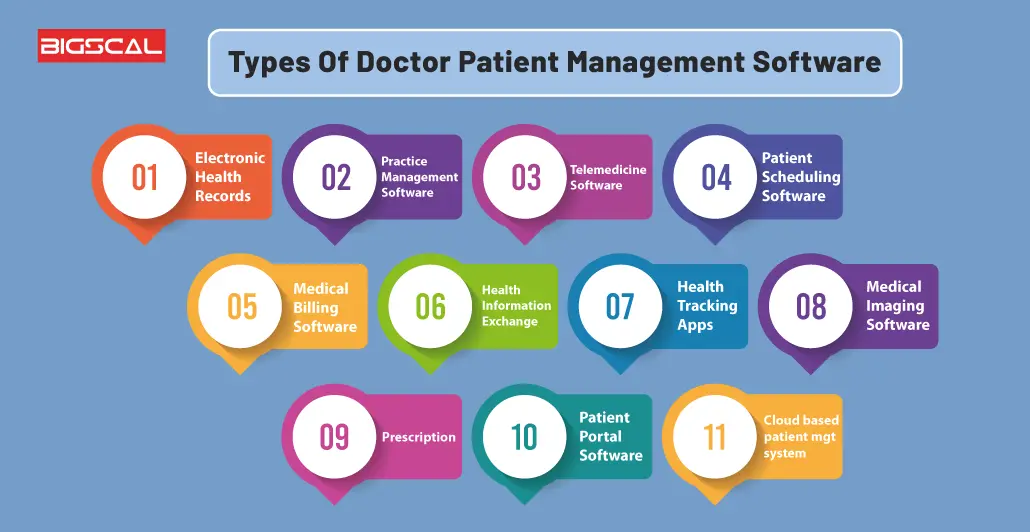
Following are the types of Doctor Patient Management Systems:
- Electronic Health Records
- Hospital Management Software
- Practice Management Software
- Telemedicine Software
- Patient Scheduling Software
- Medical Billing Software
- Health Information Exchange (HIE) Software
- Remote Monitoring and Health Tracking Apps
- Medical Imaging Software
- Prescription and Medication Management Software
- Patient Portal Software
- Cloud-based patient management system
Read more: How To Create Hospital Management Software: Step-By-Step Guide
Key Features Of Doctor-Patient Management Software
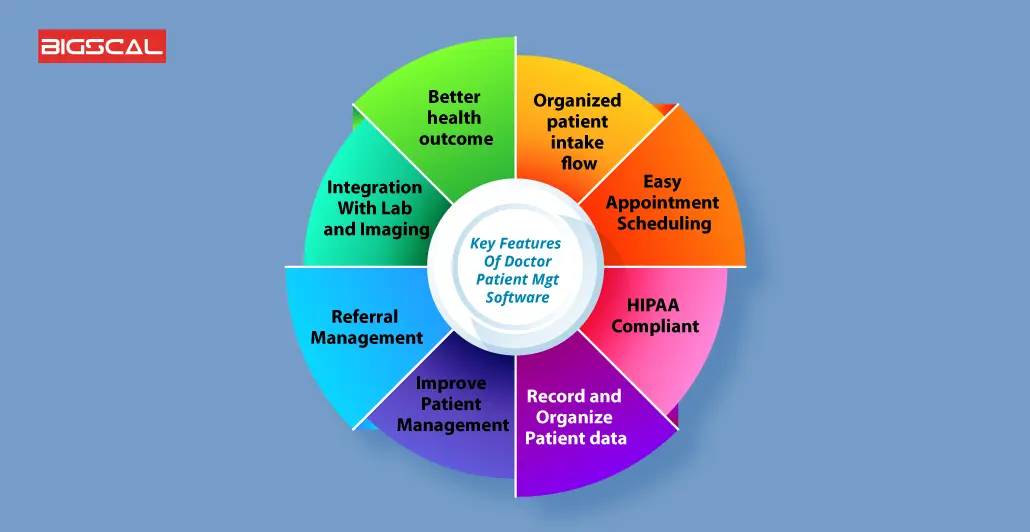
The doctor-patient management system, or a doctor-patient relationship management software, is full of specialities and benefits. Let’s read out all its Key Features:
Better health outcome
Doctor Patient Management Software plays a vital role in improving health outcomes. It does this by ensuring that medical professionals have easy access to a patient’s medical history, treatment plans, and test results. This means doctors can make more informed decisions about a patient’s care. Additionally, these same patient management systems often include reminders for follow-up appointments and medication schedules. It helps patients stay on track with their treatments.
Moreover, facilitating better communication between healthcare providers reduces the chances of errors in diagnosis or treatment. This results in better health outcomes and safer and more effective healthcare. Overall, the software helps in keeping patients healthier by using patient management solutions enabling doctors to provide more accurate and timely care.
Organized patient intake flow
Patient intake flow refers to the process a patient goes through when visiting a healthcare facility. Doctor Patient Management Software streamlines this process by automating tasks such as registration and insurance verification. This management solution not only saves time but also reduces the chances of errors in paperwork.
Furthermore, the application maintains the digital database of patients’ data, so that clinicians can access, edit and update it at any time. Subsequently, clinicians can allot more time with patients, delivering services of quality rather than being focused to menial tasks that end up taking their precious time.
This better organization helps to make the leap between the patient journey from the start to the end leaner, more pleasant and more expedient. It is equivalent to elimination of paperwork from the mess of delivering healthcare on time, efficiently and effectively despite the locations.
Easy Appointment Scheduling
The Doctor-Patient Management Software not only facilitates appointment scheduling but also helps block some slots. Thus reduces the work process for medical practitioners and patients. Now you can book your doctor’s appointments online from the peace and comfort of the privacy of your home.
It resembles a way of a table booking but to use them healthcare provider and your health. Visit the location, check if you have time, select a free time, and take the place where you fit in. This provides a convenient way for clients to get their queries settled without having to call the clinic and stay on hold.
HIPAA Compliant
HIPAA, which stands for the Health Insurance Portability and Accountability Act, is a standard law providing the patient’s private medical details with the certainty of security. If a software is HIPAA compliant it indicates that the software has the highest degree of security and privacy measures.
The information regarding patients such as their health details is stored safely and under high security and confidentiality. It’s a personal vault (an electronic one), if you will, for your medical records. This privacy is only seen by doctors with medical practice. Only authorized people can have access to and share this information. Therefore, no worries at all regarding your health data and that of your patient because the Doctor Patient Management Software that is HIPAA compliant is the place to go and store it safely.
Record and Organize Patient data
Doctor-patient programs give physicians access to sensitive data on their patients that can aid in treatment planning and follow-up. It provides doctors and their colleagues with a platform where they can key in vital details such as patient names, contact information, medical history, tests, treatments, and prescriptions in one easy location.
This results in the streamlining of the procedure concerning patient record retrieval and updating, thus making it possible to do the healthcare provision quickly and accurately. Furthermore, the systems hold the database which facilitate patients privacy and refers back to healthcare regulations.
Improve Patient Management
This software improves the overall management of patients within a healthcare setting. It simplifies various aspects of patient care. Which includes appointment scheduling, billing, and communication. Patients can often book appointments online, reducing wait times and increasing convenience.
Additionally, healthcare providers can better coordinate care by sharing patient data with medical centres within their network. Moreover, it helps doctors and their teams provide more efficient and patient-focused healthcare services.
Referral Management
It simplifies the process of referring patients to specialists or other healthcare facilities. The software helps your doctor create and track the referral, making sure the patient gets the right care. It also helps in managing the entire referral workflow, from sending the referral to receiving the specialist’s feedback.
This feature ensures that patients receive the right treatment at the right time and helps doctors coordinate care across patient populations more effectively.
Integration With Lab and Imaging
Integration with lab and imaging services is another important aspect of patient management software. This feature enables doctors to request seamlessly and access laboratory tests and medical imaging results directly within the software.
For instance, if your doctor needs to order a blood test or review your X-ray, they can do it without needing to use a separate system. This integration not only saves time but also reduces the chances of errors in transmitting crucial medical data.
It allows for a more efficient view of a patient’s health by providing access to diagnostic reports, making the diagnostic process smoother and more efficient. In essence, it is a centralized platform that streamlines the entire healthcare process and improves the quality of patients’ care.
Customization
Doctor Patient Management Software allows healthcare providers to personalize the system to meet their specific needs. This means they can tailor the software to match their workflows, preferences, and specialities. Customization might include:
- Adding or removing features.
- Setting up appointment schedules.
- Even changing the user interface to make it more user-friendly.
By doing so, doctors and staff can work more efficiently and provide better patient care. It’s like adjusting your car’s settings to make your drive more comfortable and efficient.
Secure data Storage
Data security is crucial in the healthcare sector. Doctor Patient Management Software ensures that patients’ information is stored safely and confidentially. It’s like a digital vault for medical records, protecting sensitive details from unauthorized access.
This security includes encryption, access control, and regular backups, just like locking your home and having a security system to safeguard your valuables.
Patient Check-in
Patient check-in features in the software streamline the process of registering and welcoming patients at the clinic or hospital. It’s like having a digital receptionist who manages appointments, verifies patient details, and helps staff know who’s waiting.
This enhances the patient experience by reducing wait times and making the check-in patient discharge process more efficient and organized. It’s similar to checking in at an airport, where you confirm your presence and get ready for your journey without much hassle.
Read more: Patient Journey Management Software: Why Hospitals Need It
5 Best Patient Management Software
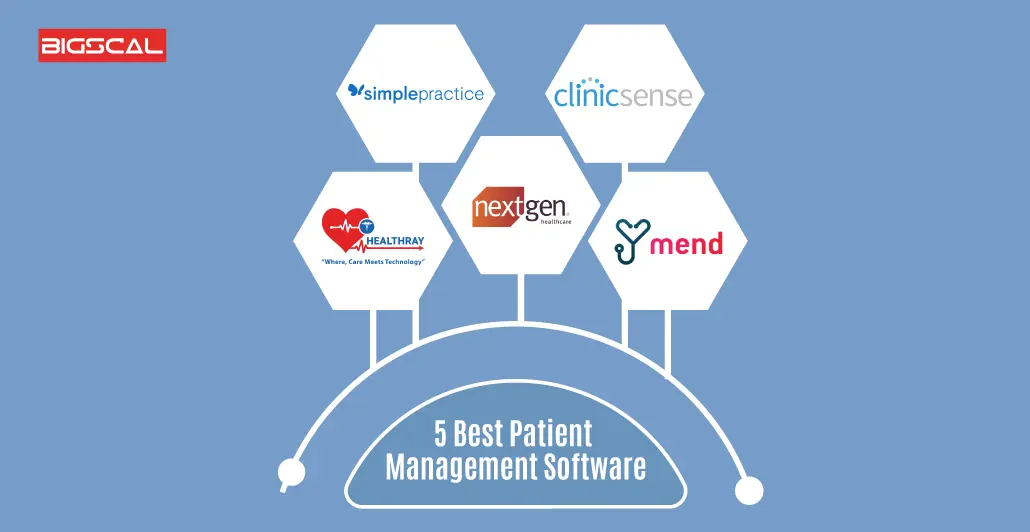
Heathray
Healthray is patient management software that helps doctors by simplifying their tasks. It offers features for appointment scheduling, patient records, billing, and insurance management. Its user-friendly interface makes it easy for staff to navigate, ensuring efficient patient care. Additionally, Heathray provides data analytics tools to track patient outcomes and improve healthcare services.
SimplePractice
SimplePractice is a user-friendly platform for therapists and mental health professionals. In addition, it’s kind of like using physiotherapy patient management software. It allows them to manage patient accounts, appointments, billing, and treatment notes. Additionally, it also offers a patient portal for secure communication. SimplePractice stands out for its intuitive design and customizable features, making it a top choice for mental health practitioners.
NextGen Healthcare
NextGen Healthcare is a solution for medical practices and clinics. It covers appointment scheduling, electronic health records (EHR), and revenue cycle management. In addition, it also offers analytics tools to enhance decision-making. NextGen’s versatile features make it a good choice for healthcare facilities of all sizes.
Mend
Mend is a telehealth and patient engagement platform that connects healthcare providers and patients through video consultations and secure messaging. It’s particularly valuable for remote care and telemedicine services. Mend simplifies appointment scheduling and offers a patient-friendly interface, enhancing the patient-provider relationship in the digital healthcare world.
ClinicSense
ClinicSense is a patient management software personalized for massage therapists and holistic health practitioners. It aids in scheduling, client management, and invoicing. In addition, its intuitive interface simplifies administrative tasks, allowing therapists to focus on their clients. ClinicSense’s specialization in alternative healthcare makes it a top choice for those in this field.
Read more: Types Of Telemedicine: Benefits, Types, And Examples
Why Is Bigscal the Best Company To Develop a Patient Management System?
If you, too, need software to manage patients in your hospital, approach Bigscal. Now you must be thinking of why only Bigscal. So, Bigscal is an ideal choice for developing a patient management system due to our expertise and commitment to developing immersive healthcare software solutions.
Our skilled developers have industry-specific knowledge that is a must to maintain law and security standards. Furthermore, Bigscal’s solutions are user-friendly, enhancing healthcare professionals’ efficiency and patient care. Moreover, we prioritize scalability and customization, accommodating organizations of all sizes and adapting to evolving healthcare requirements.
So, Our commitment to continuous improvement means that its Patient Management System will stay up-to-date with the latest industry standards and technological advancements. By choosing us, you can benefit from a reliable, secure, and adaptable patient management system designed to enhance patient care and streamline operations.
Conclusion
So, now we hope you understand what doctor-patient management software is and what are its key features. By harnessing this technology or software you will get many features like Better health outcomes, Organized patient intake flow, Improve Patient Management, and more. Without waiting give this top patient retention software a chance.
FAQ
What is the best patient and management system in healthcare?
A patient management system in healthcare could be described as a software application or a computer system through which the providers of care maintain patients’ details, appointments, tests, history, and bills. They help in minimizing the paperwork, providing better management of care, and accuracy of the information stored, leading to better health care service delivery.
What are examples of patient management?
There are several patient management systems which are explained below: Some of the well-known electronic health record systems are Epic, and Cerner patient management systems that are able to handle large amounts of data for hospitals and other large health facilities. MHSs enable doctors, nurses and other healthcare providers to make patient appointments, capture and store patient information and treatment details such as prescribed drugs, and address accounts receivable and other financial issues relating to patient services.
What is PM and EHR software?
PM (Practice Management) software is a healthcare system that assists medical practices to manage administrative and financial processes. It also consists of functions for time & appointment management, fees and charges, as well as for insurance claims.
What are the steps of patient management?
- Registration: Collect patient information.
- Scheduling: Appointments and follow-ups.
- Medical Records: Record key data pertaining to the patient and also their medical history.
- Billing and Payments: The final function of management of the operations of a business outlines the managerial practice in managing the financial aspects of a business.
- Treatment: Admissions Essay The situation may need diagnosis and treatment in the case of the patient.
- Follow-up: It is used to follow the results of certain activities and to deliver constant support.
- Reporting: Create documented information and review research findings in relation to quality enhancement.
- Discharge: Wrap up patient care.
- Patient management involves different aspects of the patient’s care and is a sure way of guaranteeing a proper management of the patient.
What is the most popular medical software?
Among the modern medical applications, Epic Systems’ Epic EHR software was one of the leading and most widely implemented solutions for large health care systems. Some of the most common medical software applications are Cerner, All scripts and Medica technologies.
